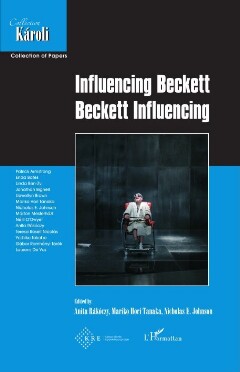Oldal 43 [43]
LAURENS DE Vos
perfectly well that the act of looking is not an innocent contemplative act but
radically changes the relation between the subject and the object of viewing.
It always connects both poles and thus renegotiates the terms on which one’s
world is constructed. With regard to the dynamics of the look, Heidegger’s
influence on Sartre is indisputable. “World,” Heidegger said, “is never an
object that stands before us and can be seen. World is the ever-nonobjective
to which we are subject as long as the paths of birth and death, blessing and
curse transport us into Being." However, for the French existentialist, it
never comes to an ocular interaction between the one watching and the one
being watched. From the latter’s perspective, the other’s look always entails
a deprivation of his self. Upon meeting the eye of someone else the point of
centralization that is crystallized in someone is destabilized, Sartre argues.
In the awareness of another point of view from which one is being looked at,
one is no longer the center of one’s universe. The arrangement of one’s world
shifts radically from oneself as its center to the one watching and imposing a
drastically other perspective on the world. The order as it was always known
to one becomes threatened. What Sartre describes philosophically parallels
Rubin’s psychological figure-ground perception.
Gone is the Cartesian perspectival all-seeing and hence omniscient gaze
by which the observer is not affected in the formation of his own subjectivity.
If the Western tradition emerging in the wake of Descartes could derive its
ontological stability from a self- or ego-conscious driven mind-set, in the
twentieth century this view is disrupted and yields to an epistemological
suspicion of ocular-based knowledge.
Beckett was fairly well acquainted with Sartre, and showed a lot of
enthusiasm for La Nausée, though — as James Knowlson adds in his biography
— they were not close friends.?? This may have been effected by the dispute with
Sartre’s wife Simone de Beauvoir over her refusal to publish the second part of
“Suite” (“The End”) in Les Temps Modernes. Despite what Beckett called this
“resounding difference of opinion,”*° Sartre would nonetheless later suggest to
Beckett that he might contribute another piece for his journal. More important
than their personal relationship, however, is the influence that Sartre’s
existentialist thinking exerted on Beckett. In part, Endgame can be seen as
a theatricalization of the program of the cubist art style and the concomitant
destabilization of inner and outer, foreground and background. Shaping the
world, additionally, is strongly bound up with the scopic illusions that are at
Otd. in Martin Jay: Downcast Eyes: The Denigration of Vision in Twentieth-Century French
Thought, Berkeley, University of California, 1993, 272.
James Knowlson: Damned to Fame: The Life of Samuel Beckett, London, Bloomsbury, 1996,
359.
30 Samuel Beckett: The Letters of Samuel Beckett, 1941-1956, Vol. 2, eds. George Craig —
Martha Dow Fehsenfeld — Dan Gunn - Lois More Overbeck, Cambridge, Cambridge
University, 2011, 47.
s 42 e

